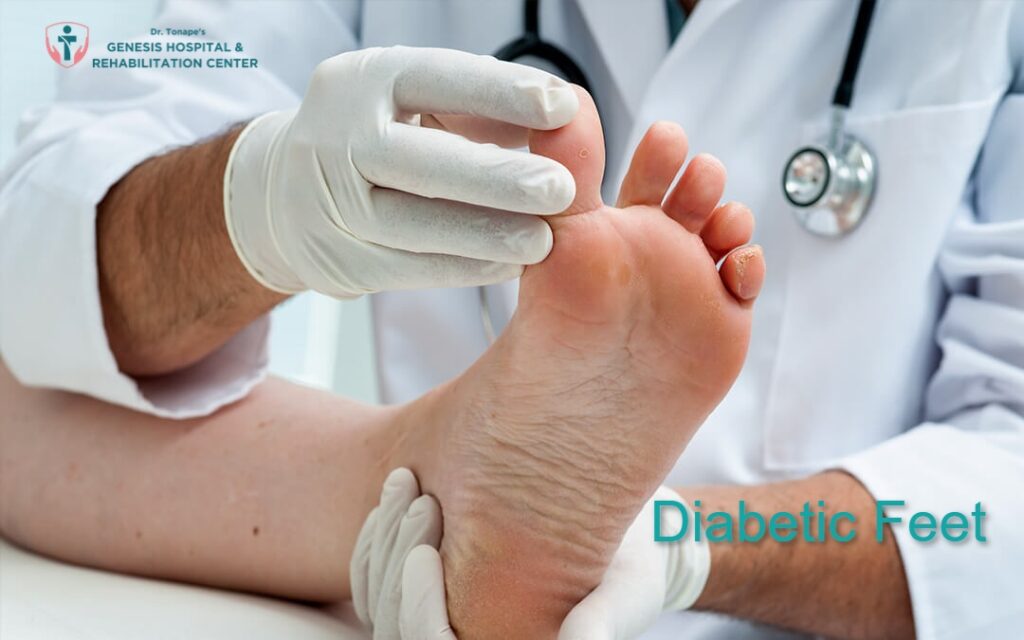For most people, a small cut or scrape on the foot may seem minor and harmless. But for individuals living with diabetes, even a simple wound can escalate into a serious, life-threatening infection if not treated properly. That’s why proper diabetic foot care in Pimpri-Chinchwad is essential for patients managing this chronic condition. Diabetes not only affects blood sugar levels but also weakens the immune system, reduces blood flow, and damages nerves—all of which raise the risk of developing severe foot problems.
Why Diabetics Are More Vulnerable to Foot Infections
Diabetes affects the body in many ways, but two complications make the feet especially vulnerable:
1. Peripheral Neuropathy (Nerve Damage)
Over time, high blood sugar damages the nerves, especially in the legs and feet. This results in numbness, tingling, or loss of sensation, making it hard for patients to feel pain, heat, or injury. A diabetic patient may not notice a small cut, blister, or puncture until it has already become infected.
2. Poor Blood Circulation
Diabetes narrows and hardens the blood vessels, especially in the lower limbs. This condition—called peripheral artery disease (PAD)—slows down wound healing and reduces the body’s ability to fight infection. As a result, even a minor foot wound can fester and develop into a serious ulcer or abscess.
Common Causes of Foot Injuries in Diabetics
Small and seemingly trivial injuries can lead to complications. Some common causes include:
-
Wearing ill-fitting shoes that cause blisters or pressure sores
-
Walking barefoot, especially outdoors or on rough surfaces
-
Improper nail trimming that leads to cuts or ingrown toenails
-
Minor burns from hot water or heating pads
-
Cuts from sharp objects, unnoticed due to nerve damage
Signs of a Serious Infection
Diabetic foot infections can escalate quickly. Look out for:
-
Swelling or redness in the foot
-
Persistent warmth or tenderness
-
Foul-smelling discharge from a wound
-
Pus or oozing fluid
-
Fever or chills
-
Black tissue (gangrene), indicating tissue death
-
Pain or difficulty walking
If you or someone you know experiences these signs, seek medical help immediately from a clinic specializing in diabetic foot care in Pimpri-Chinchwad.
The Danger of Delayed Treatment
Delayed or improper treatment of foot infections can result in:
-
Chronic ulcers that are difficult to heal
-
Spreading infections that may reach the bones (osteomyelitis)
-
Tissue death (gangrene) requiring surgical removal
-
Amputation of toes, feet, or even part of the leg
Sadly, diabetic foot complications are among the leading causes of non-traumatic lower limb amputations worldwide. Many of these are preventable with early detection and proper care.
Essential Tips for Diabetic Foot Care
Preventing infection starts with daily foot care and lifestyle management. Here are some expert tips:
-
Inspect your feet daily for cuts, sores, redness, swelling, or blisters. Use a mirror or ask for help if needed.
-
Wash feet daily with lukewarm water and mild soap. Dry thoroughly, especially between the toes.
-
Moisturize your feet, but avoid applying cream between the toes to prevent fungal growth.
-
Trim toenails carefully, straight across, and never too short.
-
Avoid walking barefoot, even at home. Wear socks and soft, well-fitted shoes.
-
Choose proper footwear designed for diabetic patients to reduce pressure points.
-
Never treat corns or calluses on your own. Consult a doctor or podiatrist.
-
Control blood sugar levels to improve healing and immunity.
-
Quit smoking, as it worsens circulation issues.
-
Schedule regular check-ups with a diabetes specialist or a clinic focused on diabetic foot care in Pimpri-Chinchwad.
When to See a Specialist
Don’t wait for visible signs of infection. If you have diabetes and notice any cut, blister, or sore that doesn’t heal in a few days, consult a healthcare provider. Early intervention can prevent complications and improve outcomes dramatically.
Conclusion
For people with diabetes, a simple foot wound is never “just a cut.” Without proper care, it can lead to serious complications—including infection, tissue damage, and even amputation. That’s why diabetic foot care in Pimpri-Chinchwad is not a luxury but a necessity. With regular check-ups, preventive steps, and timely medical attention, patients can protect their feet and live healthier, more confident lives.

